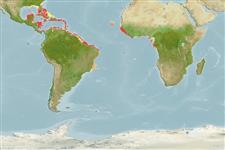Common names from other countries
Environment: milieu / climate zone / depth range / distribution range
Ekologi
Berasosiasi dengan karang; kisaran kedalaman 0 - 30 m (Ref. 848). Subtropical; 33°N - 25°S, 92°W - 12°E (Ref. 848)
Atlantic Ocean.
Length at first maturity / Size / Weight / umur
Maturity: Lm ? range ? - ? cm Max length : 5.0 cm COLD jantan/; (Ref. )
Colony: small, usually less than 50 mm across, hemispherical to encrusting. Corallites: shape range from immersed to conical to tubular, may be circular with one mouth, to elongate with multiple mouths; intertidal encrusting colonies may be submeandroid; spherical colonies with unrestricted growing space often with tubular corallites; valleys seldom more than 5 mm across; walls neatly rounded, whatever the corallite shape. Septo-costae exsert and evenly spaced. Color: often tan to light orange-brown with pale green tentacles (Ref. 848).
Zooxanthellate (Ref. 116012). Common in shallow less than 15 m; reef habitats and sometimes seagrass beds (Ref. 415). Also in intertidal rock pools and shallow reef environments (Ref. 848).
Life cycle and mating behavior
Kematangan | Reproduksi, perkembang biakan | Pemijahan | telur-telur | Fecundity | Larva
Hermaphroditic (Ref. 113712). Mature gametes are shed into the coelenteron and spawned through the mouth. Life cycle: The zygote develops into a planktonic planula larva. Metamorphosis begins with early morphogenesis of tentacles, septa and pharynx before larval settlement on the aboral end (Ref. 833).
rujukan utama
Acuan | Koordinator | mitra
Collin, R., M.C. Díaz, J. Norenburg, R.M. Rocha, J.A. Sánchez, M. Schulze, A. Schwartz and A. Valdés. 2005. (Ref. 415)
Status IUCN Red List (Ref. 130435)
status CITES (Ref. 108899)
Not Evaluated
penggunaan manusia
| FishSource |
Alat, peralatan
informasi lanjut
Umur / SaizPertumbuhanpanjang-beratpanjang-panjangMorfologiLarvaKelimpahan
Sumber internet
Estimates based on models
Preferred temperature
(Ref.
115969): 26.2 - 28.1, mean 27.5 (based on 798 cells).
kategori harga
Unknown.
